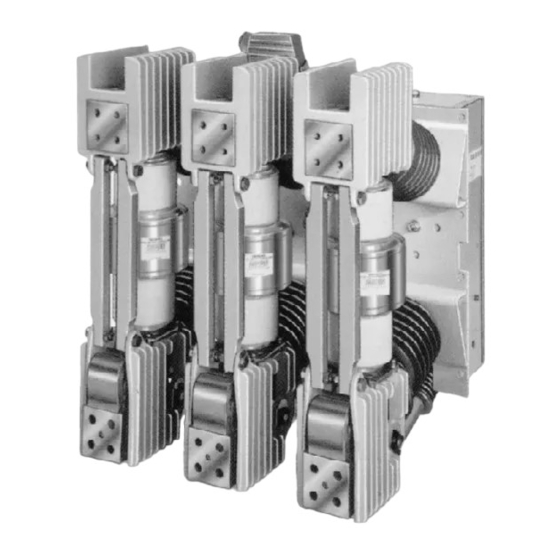Siemens 3AH Інструкції, монтаж, експлуатація, технічне обслуговування - Сторінка 23
Переглянути онлайн або завантажити pdf Інструкції, монтаж, експлуатація, технічне обслуговування для Промислове обладнання Siemens 3AH. Siemens 3AH 33 сторінки. Vacuum circuit breaker operator module
Також для Siemens 3AH: Експлуатація та технічне обслуговування установки (20 сторінок), Інструкція з експлуатації (38 сторінок)

Maintenance
Insulation and Contact Resistance Test Procedure
1. Observe safety precaution listed in the danger and cau-
tion advisories for the Vacuum Integrity Check tests.
2. Close the circuit breaker. Ground each pole not under
test. Use manual charging, closing and tripping pro-
cedures.
3. Apply the proper AC or DC (Table 3) high potential test
voltage between a primary conductor of the pole and
ground for one minute.
4. If no disruptive discharge occurs, the insulation sys-
tem is satisfactory.
5. After test, ground both ends and the middle of each
vacuum bottle to dissipate any static charge.
6. Disconnect the leads to the spring charging motor.
7. Connect all points of the secondary disconnect with a
shorting wire. Connect the shorting wire to the high
potential lead of the high voltage tester, and ground
the breaker housing. Starting with zero volts, gradu-
ally increase the test voltage to 1500 volts rms, 60 Hz.
Maintain test voltage for one minute.
8. If no disruptive discharge occurs, the secondary con-
trol insulation level is satisfactory.
9. Disconnect the shorting wire and re-attach the leads
to the spring charging motor.
10. Perform contact resistance tests of the primary con-
tacts. The resistance should be read between the lower
and upper terminal pads (Figure 16). Contact resis-
tance should not exceed the values listed in Table 5.
Table 5. Maximum Contact Resistance
Current Rating
(Amps)
1200
2000
3000
Contact Resistance
(Micro-Ohms)
35
30
30
Inspection and Cleaning of Breaker Insulation
1. Perform the Spring Discharge Check on the circuit
breaker after all control power is removed. The Spring
Discharge Check consists of 1) depressing the red Trip
pushbutton, 2) then depressing the black Close
pushbutton, and 3) again depressing the red Trip
pushbutton. All of these controls are on the breaker
front panel. visually verify the Discharge condition of
the springs.
2. Remove any interphase and outerphase barriers if fur-
nished (applicable for certain types only).
3. Clean barriers and post insulators using clean cloth
and one of the following solvents:
• No. 2 or No. 2 denatured alcohol
• Isopropyl or isobutyl alcohol
4. Replace all barriers. Check all visible fasteners again
for condition and tightness.
Note: Do not use any cleaning compounds contain-
ing chlorinated hydrocarbons such as trichlorethyl-
ene, perchlorethylene or carbon tetrachloride.
These compounds will damage the phenylene ether
copolymer material used in the barriers and other
insulation on the circuit breaker.
Functional Tests
Refer to the Installation Checklist in the Installation Checks
and Initial Functional Tests section of this manual. Func-
tional tests consist of performing at least three (3) Manual
Spring Charging Checks and three (3) Automatic Spring
Charging Checks. After these tests are complete, and the
springs fully discharged, all fasteners and connections are
checked again for tightness and condition.
22
